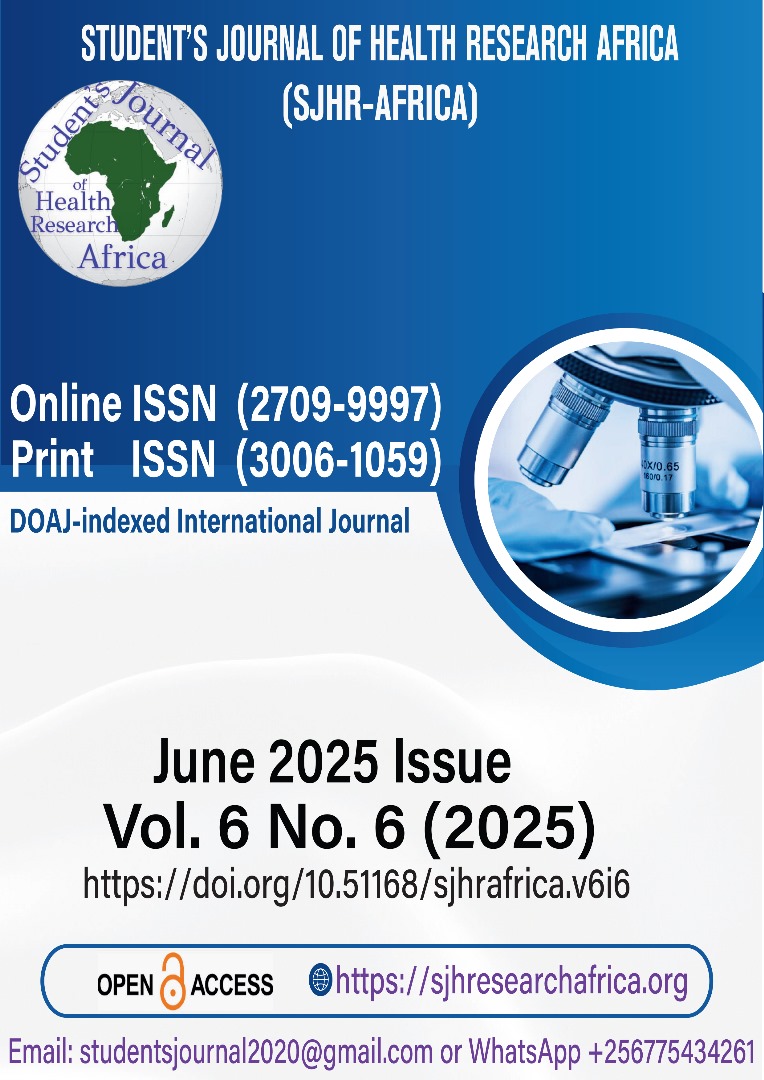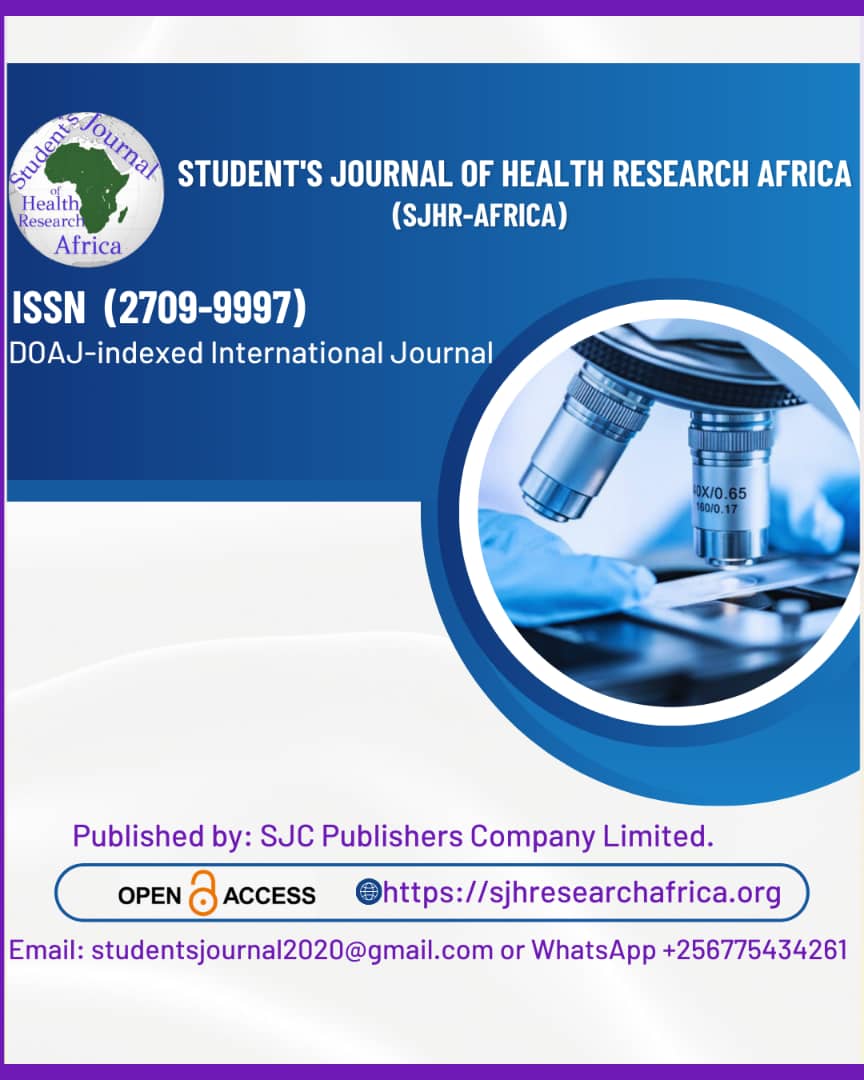Examining Genital Infections in Type 2 Diabetes: A Retrospective Analysis of Three Tertiary Hospitals in South Africa
DOI:
https://doi.org/10.51168/sjhrafrica.v6i6.1519Keywords:
Communicable diseases, Non communicable diseasesAbstract
AbstractIntroduction:
This study investigated the prevalence and characteristics of genital infections among patients with Type 2 Diabetes (T2D) in KwaZulu-Natal (KZN), South Africa. The increasing prevalence of T2D in the region necessitates understanding its health implications, especially the link between diabetes and genital infections. The study aimed to identify common pathogens and assess the correlation between glycaemic control (HbA1c levels) and infection rates.
Method:
A retrospective analysis was conducted on laboratory data from 300 T2D patients. The study examined infection rates and identified pathogens, with a focus on the relationship between infection prevalence and HbA1c levels.
Results:
Of the 300 patients, 73 (24.3%) tested positive for genital infections. Candida species were the most common pathogens, found in 49% of cases. A significant association was found between elevated HbA1c levels and increased infection rates, with patients having HbA1c levels above 7.5% showing the highest frequency of infections.
Conclusion:
The study highlights the increased risk of genital infections in T2D patients, particularly those with poor glycaemic control. Uncontrolled diabetes, as indicated by elevated HbA1c levels, significantly raises susceptibility to infections.
Recommendations:
Healthcare providers should increase awareness of genital infection risks in diabetic patients and prioritize regular screenings. Effective glycaemic control, patient education on hygiene, and early medical intervention for infections are essential to improve outcomes and reduce infection rates in T2D patients.
References
Arakaki, R.F. (2016) ‘Sodium-glucose cotransporter-2 inhibitors and genital and urinary tract infections in type 2 diabetes’, Postgraduate Medicine, 128(4), pp. 409–417. Available at: https://doi.org/10.1080/00325481.2016.1167570.
Berbudi, A., Rahmadika, N., Tjahjadi, A.I., Ruslami, R. (2020) ‘Type 2 Diabetes and its Impact on the Immune System’, Current Diabetes Reviews, 16(5), pp. 442–449. Available at: https://doi.org/10.2174/1573399815666191024085838.
Chen, R. et al. (2024) ‘Immune aging and infectious diseases’, Chinese Medical Journal, 137(24), pp. 3010–3049. Available at: https://doi.org/10.1097/CM9.0000000000003410.
Corrao, S. et al. (2025) ‘Ageing, clinical complexity, and exercise therapy: a multidimensional approach’, Frontiers in Sports and Active Living, 6, p. 1422222.Available at: https://doi.org/10.3389/fspor.2024.1422222.
Geerlings, S. et al. (2014) ‘Genital and urinary tract infections in diabetes: Impact of pharmacologically-induced glucosuria’, Diabetes Research and Clinical Practice, 103(3), pp. 373–381. Available at: https://doi.org/10.1016/j.diabres.2013.12.052.
Geerlings, S. et al. (2014) ‘Genital and urinary tract infections in diabetes: Impact of pharmacologically-induced glucosuria’, Diabetes Research and Clinical Practice, 103(3), pp. 373–381. Available at: https://doi.org/10.1016/j.diabres.2013.12.052.
Gonçalves, B., Ferreira, C., Alves, C.T., Henriques, M., Azeredo, J. and Silva, S., 2016. Vulvovaginal candidiasis: Epidemiology, microbiology and risk factors. Critical reviews in microbiology, 42(6), pp.905-927. Available at: https://doi.org/10.3109/1040841X.2015.1091805.
Grandy, S., Fox, K.M. and Hardy, E. (2013) ‘Prevalence and recurrence of urinary tract and genital infections among adults with and without type 2 diabetes mellitus in the general population: a longitudinal cohort study’, Journal of Diabetes Research and Clinical Metabolism, 2(1), p. 5. Available at: https://doi.org/10.7243/2050-0866-2-5.
Holt, R.I.G. et al. (2024) ‘Diabetes and infection: review of the epidemiology, mechanisms and principles of treatment’, Diabetologia, 67(7), pp. 1168–1180. Available at: https://doi.org/10.1007/s00125-024-06102-x.
Motala, A.A., Mbanya, J.C., Ramaiya, K., Pirie, F.J. and Ekoru, K., 2022. Type 2 diabetes mellitus in sub-Saharan Africa: challenges and opportunities. Nature Reviews Endocrinology, 18(4), pp.219-229. Available at: https://doi.org/10.1038/s41574-021-00613-y.
Njomnang Soh, P. et al. (2016) ‘Urinary and genital infections in patients with diabetes: How to diagnose and how to treat’, Diabetes & Metabolism, 42(1), pp. 16–24. Available at: https://doi.org/10.1016/j.diabet.2015.07.002.
Nyirjesy, P. and Sobel, J.D. (2013) ‘Genital Mycotic Infections in Patients With Diabetes’, Postgraduate Medicine, 125(3), pp. 33–46. Available at: https://doi.org/10.3810/pgm.2013.05.2650.
Sifunda, S., Mbewu, A.D., Mabaso, M., Manyaapelo, T., Sewpaul, R., Morgan, J.W., Harriman, N.W., Williams, D.R. and Reddy, S.P., 2023. Prevalence and psychosocial correlates of diabetes mellitus in South Africa: results from the South African National Health and Nutrition Examination Survey (SANHANES-1). International Journal of Environmental Research and Public Health, 20(10), p.5798. Available at: https://doi.org/10.3390/ijerph20105798.
Sun, H. et al. (2022) ‘IDF Diabetes Atlas: Global, regional and country-level diabetes prevalence estimates for 2021 and projections for 2045’, Diabetes research and clinical practice, 183, p. 109119.Available at: https://doi.org/10.1016/j.diabres.2021.109119.
Warner, M.S., Hannah, R. and C. Crawford, L. (2020) ‘Infectious Conditions and the Immune System in Elders’, in K.A. Collins and R.W. Byard (eds) Geriatric Forensic Medicine and Pathology. 1st edn. Cambridge University Press, pp. 281–301. Available at: https://doi.org/10.1017/9781316823040.018.
World Health Organization, 2021. Guidelines for the management of symptomatic sexually transmitted infections. Available at: https://www.who.int/publications/i/item/9789240024168.
Zeng, X. et al. (2018) ‘Risk Factors of Vulvovaginal Candidiasis among Women of Reproductive Age in Xi’an: A Cross‐Sectional Study’, BioMed research international, 2018(1), p. 9703754.Available at: https://doi.org/10.1155/2018/9703754
Published
How to Cite
Issue
Section
License
Copyright (c) 2025 Nokukhanya Thembane, Mr Sihle Bonga Nxumalo, Ziningi Nobuhle Jaya

This work is licensed under a Creative Commons Attribution-NonCommercial-NoDerivatives 4.0 International License.






















